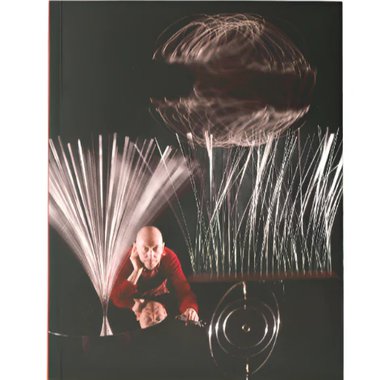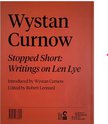John Hurrell – 14 August, 2024
Reading Curnow's explanatory introduction you quickly realise (through him) the difference between ‘wonder' as a noun and ‘wonder' as a verb. One is a sensation of exhilaration and pure delight; the other an investigative activity that might lead to problem solving—stemming from curiosity. In his writing he regularly shuffles back and forth between the two.
Auckland
Wystan Curnow
Stopped Short: Writings on Len Lye
Edited by Robert Leonard
Softcover 208 pp
This new anthology of Wystan Curnow essays can be seen as a companion volume to his earlier batch of writings Sold on Apple, 2015, that looked closely at Billy Apple’s projects and his many collaborations with the author. Though Curnow was good friends with both, Lye (1901-1980) was a very different sort of artist from the conceptualist, site-focussed Apple (1935 -2021), being extroverted, more concerned with materiality, the body of the viewer, literature in general, and an empathetic use of motion, sound and primal symbolism. And not as overtly political in his analysis of gallery space as Apple.
With this collection, a book where New Zealand Aotearoa’s most experienced art critic focusses on Lye’s varied achievements as an extraordinarily innovative kinetic sculptor, scratch and stencilling film-maker, primal-origins painter, photogram-maker and prose poet—and his status in art history—two carefully inserted commentaries allow Curnow to re-evaluate his earlier authorial thoughts in hindsight on the book’s two halves: one half (1977-2000) dealing with Curnow’s early encountering of Lye’s work in New York, initially at Howard Wise’s gallery in 1965; the other (after Lye’s death) about Lye’s works later being shipped to New Zealand Aotearoa as ‘repatriated’ art.
In the first insertion he talks about the history of his interest in Lye (born in Christchurch [like Curnow himself] but who lived most of his life in London and then New York)—and also that of his (Curnow’s) good friend Roger Horrocks (Lye’s biographer and author of Art That Moves [a look at Lye’s work])—and Curnow’s parallel interest in the projectivist verse of the Black Mountain poets Charles Olsen and Robert Creeley, which share affinities.
In the second half’s intro, he focusses on the period after Lye’s death when he, Horrocks, John Matthews, Ray Thorburn, and Hamish Keith began to set up the non-profit organisation, the Len Lye Foundation, to be based in New Plymouth and linked to the Govett-Brewster Art Gallery. It became an important contributor to New Zealand visual culture, directly through exposing Lye’s practice to the country of his birth, and through its influence. Largely through the mechanical expertise of Evan Webb, its first director (and himself a kinetic artist), long inactive broken Lye sculptures were repaired with newly constructed replacement parts, and new variations of important works (earlier planned by Lye) assembled.
Curnow’s writing covers a wide range of subjects and is fastidiously researched, with detailed footnotes at the end of each essay. The editor here is Robert Leonard, who as co-editor also worked with Christina Barton on the extraordinarily rich anthology, The Critic’s Part. That was such a wonderful showcase for Curnow’s writing in 2014, a beautifully designed (Alice Bonifant) hardcover publication that is lovely to hold and open. However, besides being solely focussed on an extraordinary sculptor and filmmaker, Stopped Short has an unexpected advantage in that the font used is bigger and for older readers much easier to read.
Some of the Lye pieces in Stopped Short are also in The Critic’s Part, but, as with Roger Horrocks, Curnow has been a Lye champion from very early on, as the superlative anthology of collected Lye prose (Figures of Motion) he and Horrocks put together in 1984 proves—and what he himself says about his very first encounters with Lye’s work. Apart from the necessary introduction at the start, and two others for the two sections, there is a wide range of erudite articles, all written for separate situations of engagement, each with its own passionate and analytic response to the featured Lye artwork.
The book’s title comes from the first quotation we find from Lye that: We’re all stopped short by wonder sometime…
The publication is in essence about Curnow’s own revelatory wonder at the work and the artist—his response: eleven perceptive essays and a remarkable in-depth interview. These are accompanied by excellent b/w and colour photographs, and at the back, facsimiles of some of the underpinning Lye/Curnow correspondence.
Reading Curnow’s explanatory introduction you quickly realise (through him) the difference between ‘wonder’ as a noun and ‘wonder’ as a verb. One is a sensation of exhilaration and pure delight; the other an investigative activity that might lead to problem solving—stemming from curiosity. In his writing he regularly shuffles back and forth between the two.
Apart from the central Lye interview, there are (for me, because of my personal taste—the activity of writing fascinates me) three other outstanding articles. (There are many so it is hard to pick.) Two are on Lye’s experimental writing: Introduction to Figures of Motion; Fizz with Zip. And another is on the photogram portraits that do not involve cameras.
In the 1984 anthology of Lye writings that Curnow assembled with Horrocks, they separate out the different types of writing he practised, in particular differentiating between scientific or theoretical writing about his many art projects, and experimental texts (poetic prose), that are about writing for its own sake as a reader experience. The latter were greatly encouraged by his friend the writer, Laura Riding.
The last sort, as a form of Bebop text construction, focusses on enjoyment of the sound, rhythms and meaning of spontaneous language. As a textual form of chopped up, yet fluid, verbally articulated scat vocalising it has an appealing vibrant energy, featuring its own unique Lye-style hep-cat urban argot where some words even seem created on the spot.
For that reason, the two presented (Curnow & Horrocks, and Curnow solo) articles are particularly useful, especially if a copy of Figures in Motion is kept close at hand. Lye’s ‘Old Brain’ type of writing (showcased in that anthology) is based on repudiating conscious control, on relying on an intuitive state where the writer is a conduit for language that flows up from his/her oldest part of the cerebral organ, and not the later-emerged pre-frontal cortex linked to mental powers and logic. The advantage was a freer, more spontaneous, less regimented type of creativity.
Lye’s writing amusingly reminds me of Truman Capote’s famous dismissal of Jack Keroauc on American television: That’s not writing; it’s typing. What upset him was Keroauc’s lack of editorial intervention; the refusal of spontaneous improvisation to tidy up, tweak or be fiddly, a laissez-faire quality which Lye admired. This sort of Lye writing, as Curnow and Horrocks are aware, is at one with the occasional unpredictability of his kinetic sculpture, i.e. a humanlike temperamental ‘personality’. Even with their programmed motors they have a built-in ‘wild card’ factor which enables the rare occurrence of surprise formations of moving steel line.
This book though—with its various textual explorations of Aotearoa NZ as a new ‘home’ for Lye’s work; the specific roles of the Lye Foundation and the Taranaki art community around it; Lye’s writing, films, sculpture and personality, and love of sound and reflected flashing light as much as trajectories of motion—is obviously Curnow’s baby, although Horrocks is co-author of one of the eleven essays. The publication is an important addition to Curnow’s list of art criticism anthologies, and so (with Leonard’s expert guidance) is of immense value for present and future generations of art history scholars.
John Hurrell


 Two Rooms presents a program of residencies and projects
Two Rooms presents a program of residencies and projects Advertising in this column
Advertising in this column



This Discussion has 0 comments.
Comment
Participate
Register to Participate.
Sign in
Sign in to an existing account.